Many remember the story of a Japanese girl and thousands of origami cranes. But not everyone knows that in Japan, along with the art of origami, there is the art of creating volumetric modules - kusudama balls.
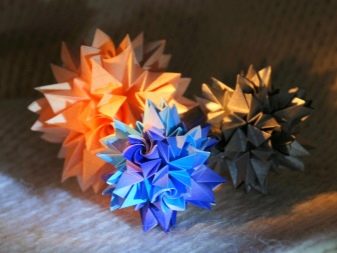
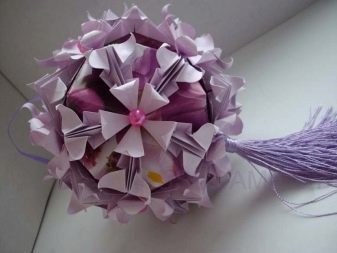
What it is?
Kusudama is a paper model. It is a spherical volumetric model assembled from numerous identical modules. Each module is a voluminous paper craft made in the origami technique. Most often, these modules are made in the form of any flowers and assembled together in a special way, they look like a big beautiful and original flower ball.
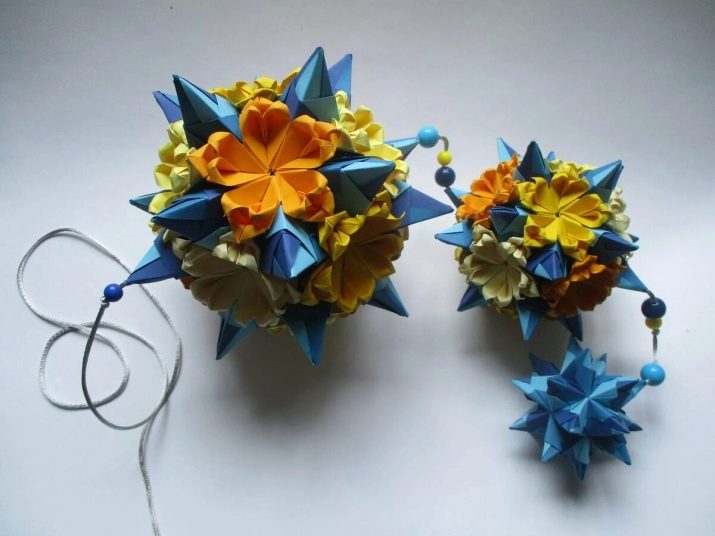
The basis of this product are regular and irregular polyhedrons.
An example of the simplest regular polyhedron is a cube. In the technique of volumetric modeling, the modules are assembled together by embedding the elements in each other, but usually in the manufacture of bites the modules are glued together or stitched together.
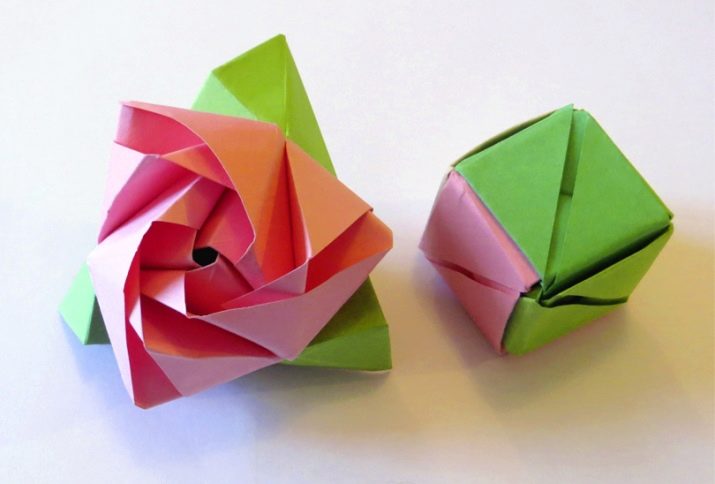
This origami technique is not very complicated, therefore it is accessible and interesting for both children and adults. For adults, especially in old age, this art grants the training of fine motor skills, the prevention of arthritis and arthrosis, and for children whose fine motor skills are not yet formed, this paper work is useful in that it trains naughty children's fingers, forms new motor skills, and develops fine musculature of the hands. It also develops such qualities in the child as perseverance, accuracy, diligence and aesthetics.
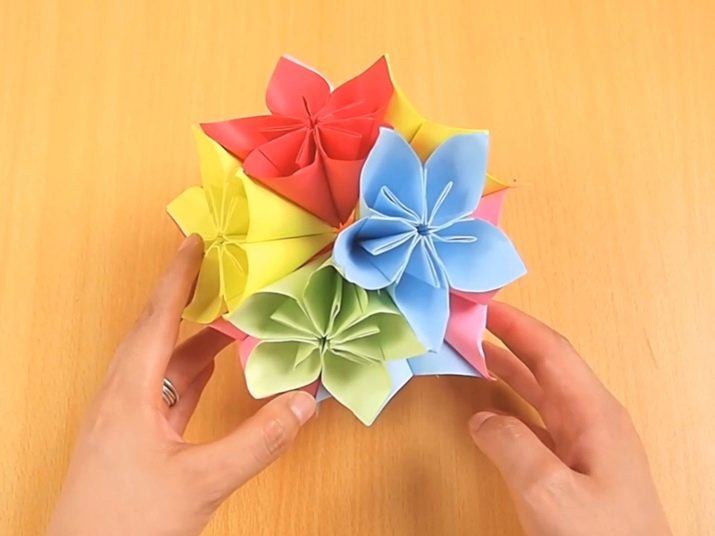
To create this type of crafts, you will need sheets of paper, preferably colored double-sided, glue, a ruler, paper clips, scissors. For decoration you need threads, beads, cords, braid.
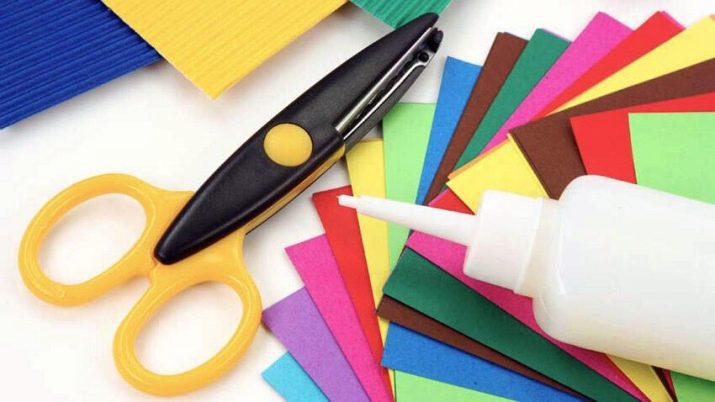
History
The meaning of the word "kusudama" in Japanese comes from the merger of two words - "kusuri" (medicine) and "tama" (ball) and means "medicinal ball". This art came from ancient times, when such balls not only decorated homes, but also filled them with positive energy and pleasant smells., since such balls were stuffed with dried medicinal herbs, incense and dry flower petals.
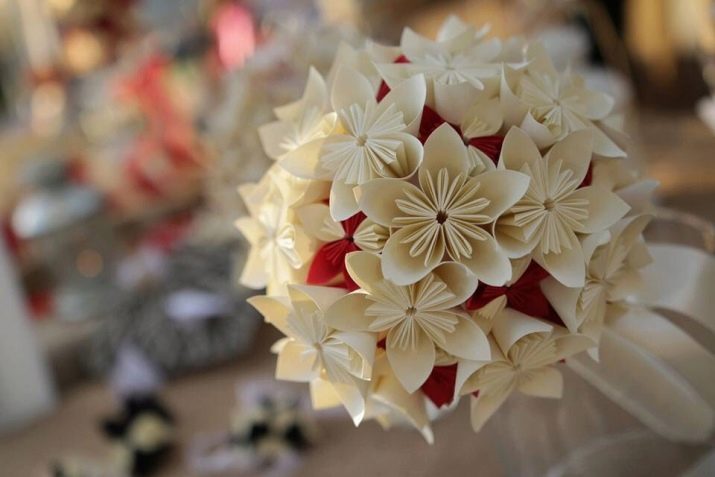
Paper was brought to Japan from China in the 7th century BC. e., and since it was very expensive material, it was used in religious services. At first, small boxes were made from it and filled with pieces of fish and vegetables. These boxes - sanbo - were used for sacrifice during ceremonies.
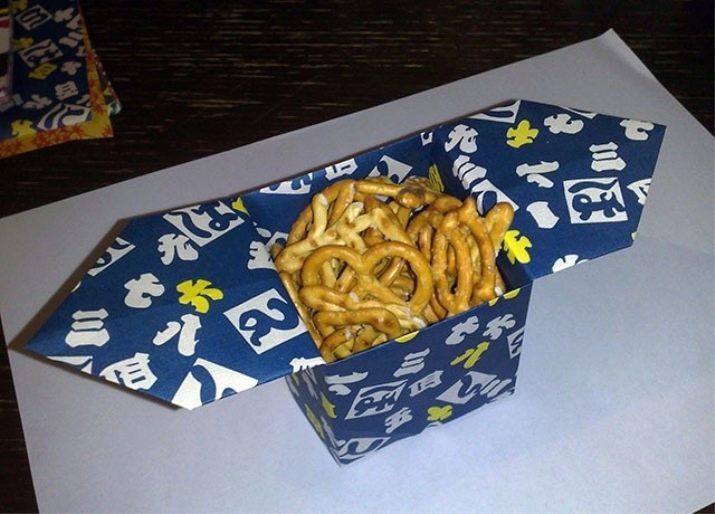
During Shinto religious rituals, worship of the sun proceeded, and the Kusudam symbolized our sun. To do this, they were collected in huge balls of red paper carnations, filled with incense, dried herbs and flower petals and placed in the four corners of the temple premises.
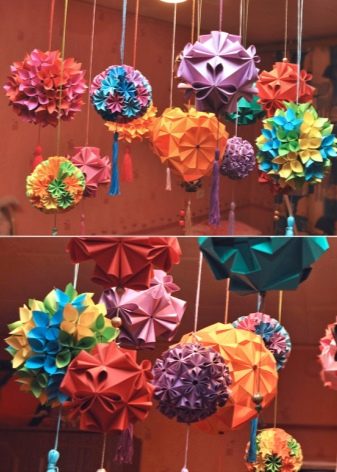
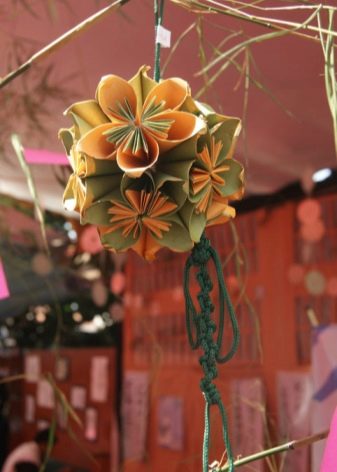
Subsequently, the Kusudamas became the decoration of the premises, decoration for festive events and a beautiful exquisite handmade gift.
Initially, the Kusudama details were not glued, but sewn together. These methods of joining parts were not recognized as origami, where the figures are created without the use of glue, thread and scissors. But gradually, Kusudama began to be considered a special section of modular origami, and with the development of glueless technology, it became one.
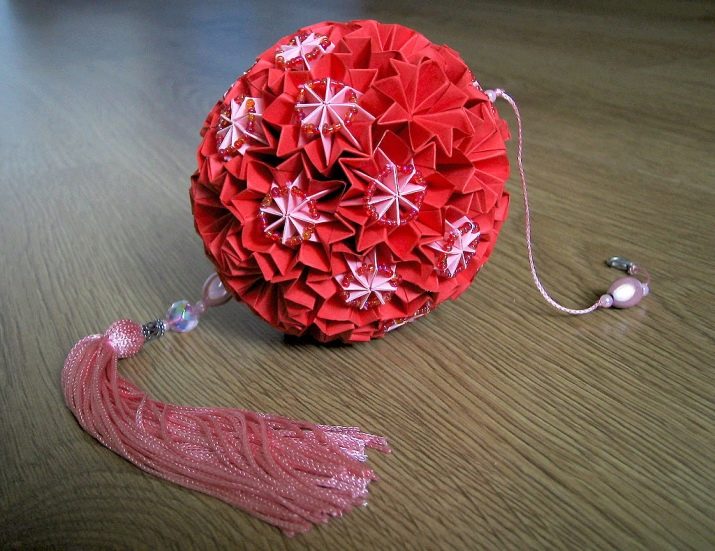
Overview of the main types
The manufacturing process of any type of bite can be divided into 3 stages.
- Accurately folding a sheet of paper in the design of a flower or figure module. Preparation of the required number of modules.
- Assembly - gluing or stitching modules in a specific sequence.
- Decoration of the finished ball. A tassel or a chain of beads is attached below. On top, you can add a loop of braid or cord to hang crafts.
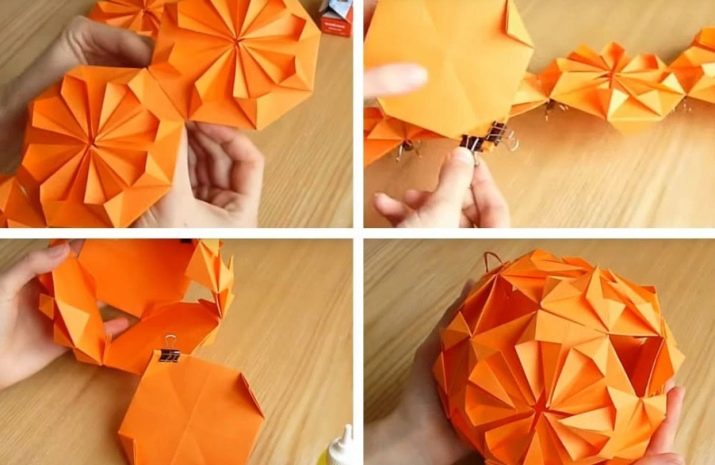
By the type of modules used - parts of crafts - these balls can be divided into several subspecies.
Classic
This is the first kind of bite, and at first they were made in the form of a box, not a ball.
It was convenient to put medicinal plants and flower petals into these boxes.
To make them, you need 6 square sheets of paper: four of them make four sides of the cube, and the other two go to the bottom and lid. The modules of this stylized ball are not glued on all sides and form triangular holes on all sides, which helps the smells of herbs and flowers to freely enter the room. The bottom is flat and quite large; it is easy to pour petals and herbs on it.

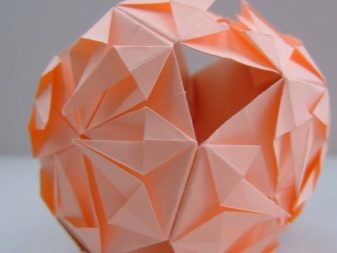
Roses
The basis of this composition is modules made in the form of roses. They are simple - rose modules, stylized and modified squares of classical Kusudama - and more complex: of a larger number of elements, made according to complex multi-pass schemes and similar to bouquets of roses.
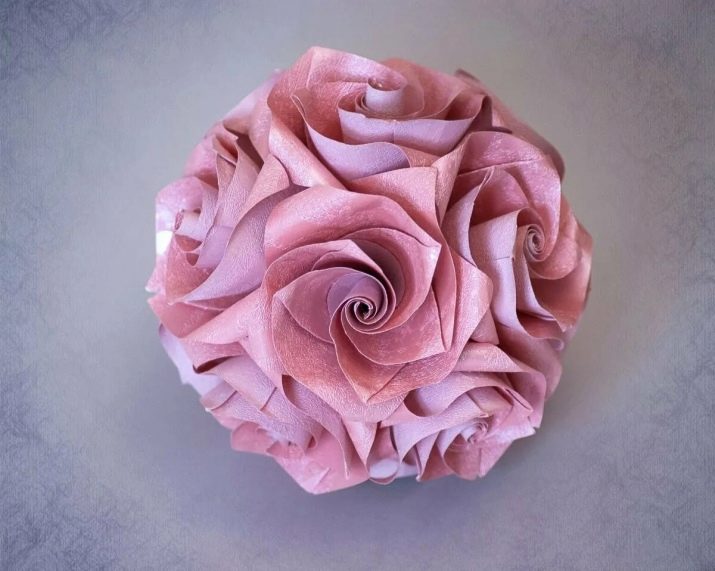
Carnations
Kusudama-clove is also called kusudama-super bowl. It is made of 30–40 color modules, stitching them together into a three-dimensional figure. Each flower is folded from a square sheet of paper.
- First, fold lines are made, after which they will collect the flower. To do this, a sheet of paper is bent in different directions: a square is folded in half, vertically and horizontally, then folds diagonally.
- The square is folded in half, bending it diagonally. The resulting right-angled triangle is folded again in half, connecting sharp edges together. You should get an isosceles right-angled triangle, whose vertex is a right angle of 90 degrees, and the other two angles lie at the base, and each is an acute angle of 45 degrees.
- Of the triangles form a rhombus, the corners of which are bent from the bottom up.When all the faces and corners of the layout are worked out, the workpiece is turned around, turned over and the flower begins to collect from the other side, carefully wrapping the edges and corners inward.
- Carnation can be made using sheets of the same color, or you can collect a multi-colored flower. All parts are stitched together and fixed with a thread.
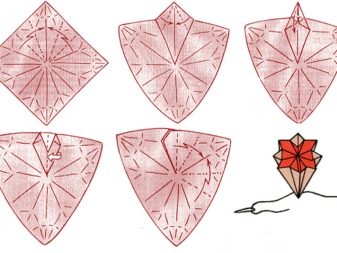
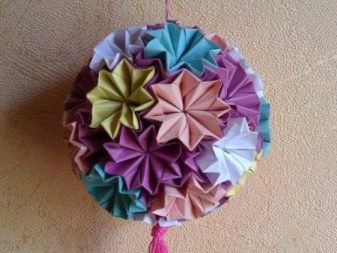
Lilies
This type of kusudama is sometimes called iris. Such a ball consists of lily flowers. For their manufacture, square sheets of 8 by 8 cm paper are suitable. You can use tear-off sheets for notes. Each flower is collected from 3 elements. A total of 36 elements: 3 for each flower.
- The petals are made according to one pattern, and the third element - sepals - is folded at the beginning in the same way, but at the end of the process one more step is added, which gives the figure a more open look. We wrap the petals to shape the lilies on a pencil.
- They collect the flower, folding each of the 3 parts into each other so that the petals are staggered and do not overlap each other.
- The resulting flowers can be supplemented with stamens, decorate the middle and collect using beads. Such a ball is glued together, placing flowers in a circle of 6 pieces, stitched in the same way or simply beautifully collected on a string.
As in nature there is a wide variety of shapes and colors of lilies, so in the origami technique, three variations of this wonderful flower are known.
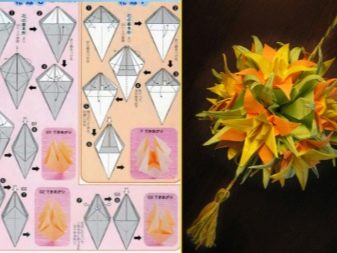
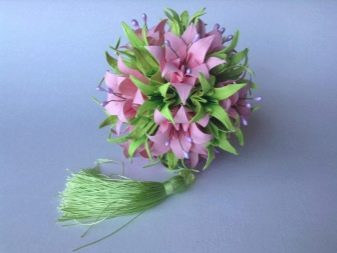
Simple flowers
A simple flower using the kusudama technique is also not so simple. Although he looks like a holistic figure, however, it consists of six elements - petals. But making them is pretty simple, even a child can cope with it on their own. Usually this manufacturing scheme is used for creativity in kindergarten, in elementary school in labor lessons. Each petal is made up of a square sheet of paper, then a flower is glued from 6 petals, and a ball is already assembled from 12 flower modules. It is considered the most simple to execute.

Electra
Kusudam Electra can be safely attributed to volumetric modeling products. Its elements are usually collected by nesting the elements of one module in another. The acute angle of the first element is inserted into a specially bent liner of the second. Also, its advantage, along with its bizarre look, is that on its basis it is possible to model new interesting forms, slightly changing the angle and shape of the folding sheet.
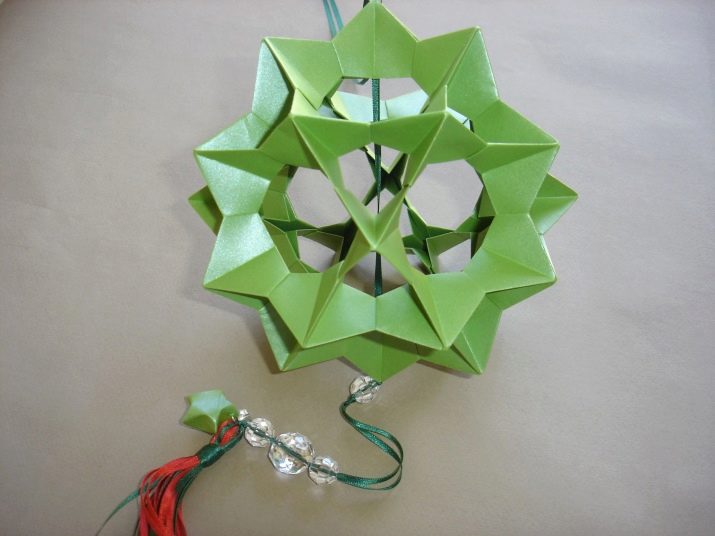
To make it, you will need 30 squares measuring 9 by 9 centimeters. You can make a larger diameter ball using larger squares. This craft is similar to a Christmas toy due to the fact that its edges are similar to large openwork stylized flowers.
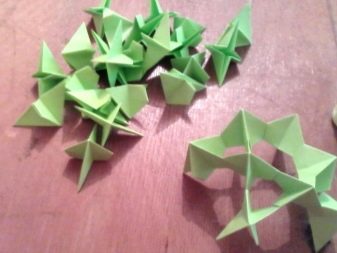
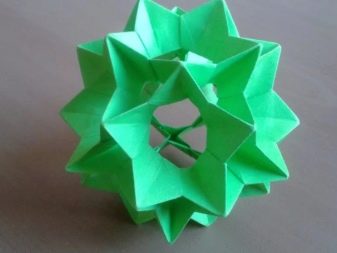
Sakura
Under this name hides several types of flower balls. Some of them are assembled from details of simple colors. Only the flowers stick together with the tips of the petals, which creates the effect of an openwork ball.

There is a variety of this flower, it is called "Sakura Kiss." This is the author’s development of the master from Russia Tatyana Vysochina. This craft is very elegant, airy and attractive. Although it will have to work hard for its execution, the result is worth the effort. Modules are assembled in inflorescences of five petals and in pyramids of three colors.
It is better to assemble them immediately, since they are easily deployed during the assembly process. But when assembled, the ball is strong enough and does not require additional sizing.
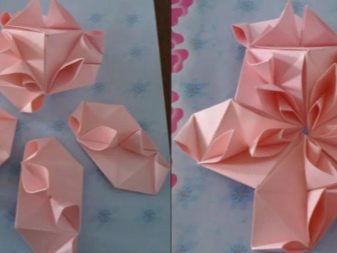
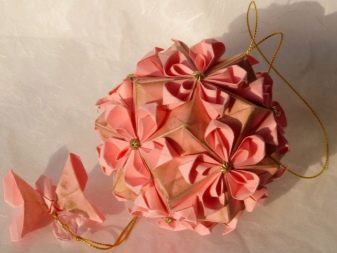
Manufacturing methods
Openwork ball
We suggest you make a magical modular ball from elements of different colors. Introducing a master class with a description and assembly diagrams step by step.
- The first color strip measuring 9 by 4.5 centimeters should be bent in half, connecting the short sides of the rectangle. Unbend it.
- Bend the left half up diagonally in the shape of a triangle. Bend the right half down diagonally in the shape of a triangle. The result is two rectangular isosceles triangles. The triangle on the left has a right angle at the top, the triangle on the right has a right angle at the bottom.The fold at both triangles is at their base.
- The left triangle needs to bend the sharp upper left corner. Bend it down to another sharp corner. At the right triangle, you need to raise and bend the lower right acute angle to the other upper acute angle. You should get a rhombus, consisting of two isosceles right-angled triangles with one common base, going in the middle from top to bottom.
- At the left triangle you need to bend up the bottom corner in the middle of the triangle. At the right triangle lower the upper corner in the middle of the triangle.
- The rhombus needs to be bent inward in half along a horizontal line to get an isosceles right triangle with a vertex - a right angle at the top. Expand the workpiece.
- For the second blank you need to take a strip of a different color. Bend it in half. Move it from the edge by 7 mm and bend again in half. Fold one side to the middle with an accordion. Fold the other side with an accordion in the other direction.
- The last folds on the accordion on both sides do not need to be done, there should remain protrusions directed by the open side in both directions. Wrap the lower left corner on the left ledge until the fold. Wrap the upper right corner down also in the form of a triangle on the right ledge.
- Turn the accordion over and place it on the first workpiece. It is necessary to reassemble the first workpiece according to the scheme and the intended bends. Collapse the first workpiece - a rhombus - into a triangle inward, so that the second workpiece-accordion is inside, and glue them in the middle. Prepare 30 pieces of the same modules.
- Glue the two modules together, gluing them near the accordion. From 5 modules, assemble in the same way one of the faces in the shape of a star. Gather and glue the remaining faces in stages to create an openwork star ball. Garnish it with a brush and glue the gimbal.
This craft can be used as a DIY Christmas toy for decorating a Christmas tree or a gift for friends.
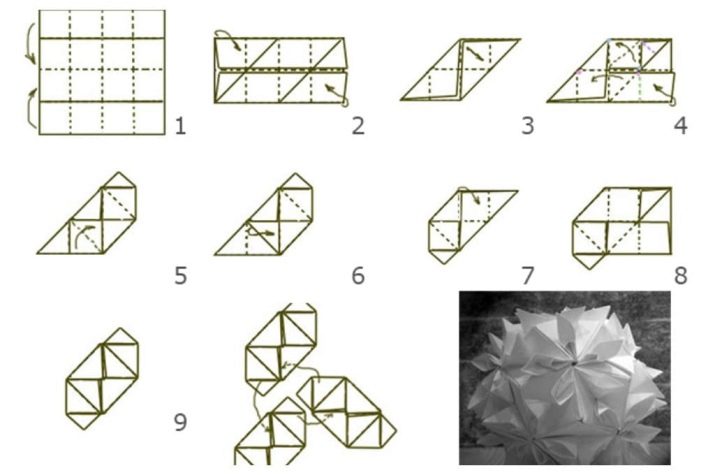
Sonobe
This kusudama rather resembles a cube made of many polyhedrons, similar to pyramids. It is based on 30 simple elements that even a beginner can do. Squares of colored paper are taken with faces from 8 to 10 cm.
You can use several different colors.
We turn each square into a figure. We make a pyramid out of three figures, putting the corner of one figure in the “pocket” of another figure, obtained by folding the part. Of the five pyramids form the side of the sonoba. With proper assembly, a neat asterisk should form at the junctions of the pyramids. If the work is done carefully, then it is possible not to glue it together - just the last two or three modules need to be connected so carefully that the work does not crumble.
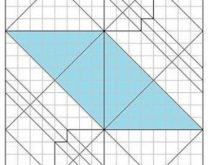
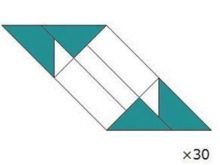
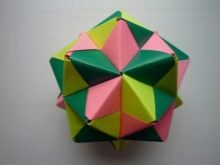
"Bells"
This is a floral arrangement of the components, which, at first glance, is difficult to do. In fact, it is not difficult to do it if you follow the instructions clearly and step by step. Each bell flower consists of five modules. In total, 60 such petals need to be made.
To collect the flower, you may need paper clips to fix it while gluing the petals with PVA glue.
The bell flowers are also glued together for each petal and fixed with paper clips until completely dry. After all the parts are firmly glued together, you can decorate the ball with a brush or thread with beads, simply stretching it through any holes in the "bell".

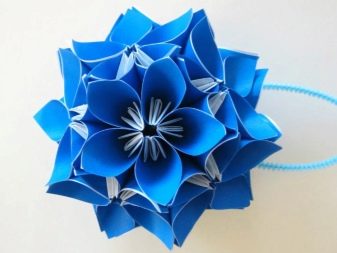
Bright Kusudama Flower
This craft is more likely not like a ball, but a single flower that opens. To make it, you will need scissors, circle patterns, glue.
- On colored paper, six circles of equal size are drawn according to the template. Carefully cut them out.
- To make one flower petal, the circle is folded in half, turned around and one of the halves is bent in the middle.
- Each quarter of the circle from the inside is smeared with glue on one side and glued so that two soft folds are inside the petal.
- All flower petals are made in the same way.
- Gather a flower, step by step gluing together all the petals in the center of the fold.
The result should be a craft that looks like a star and a flower that opens, which easily lies on the surface, is stable due to the "star" faces and can serve as the basis for a more complex craft using the kusudama technique.
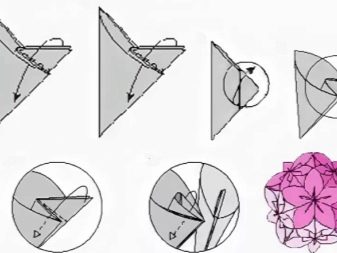
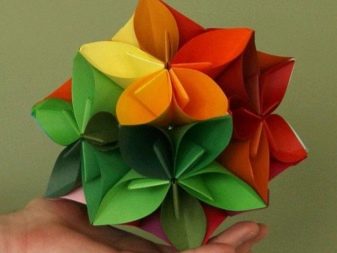
In the next video, you will be introduced to creating a simple Laconical Kusudama ball.










